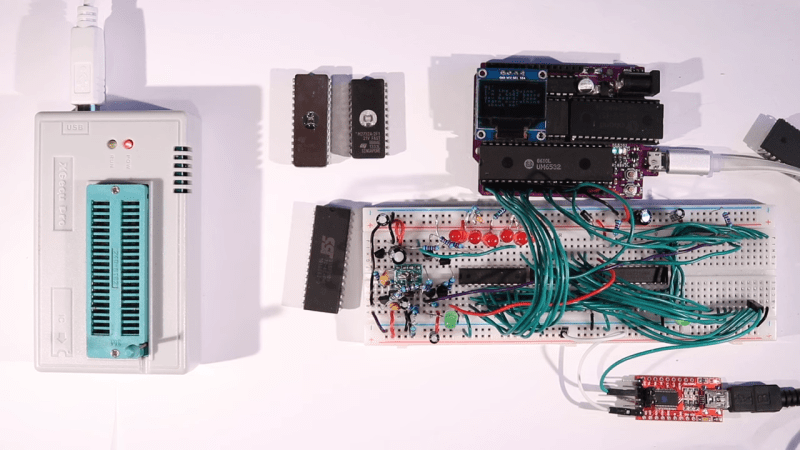There are 0x10 ways to look at ROM programmers: they’re either relatively low-cost tools that let you quickly get about the business of programming vintage ROMs and get back to your retrocomputing activities, or they’re egregiously overpriced on a per-use basis. [Anders Nielsen] seems to land in the latter camp, firmly enough that he not only designed a dedicated ROM programmer for his 65uino ecosystem, but also suffered the indignities of enlisting ChatGPT to “help” him program the thing.
We’ll explain. [Anders]’ 65uino project has been going on for a while, with low-cost ROM programming only the latest effort. To his way of thinking, a $60 or $70 programmer might just be a significant barrier to those trying to break into retrocomputing, and besides, he seems to be more about the journey than the destination. He recently tackled the problem of generating the right programming voltages; here he turns his attention to putting that to work programming vintage ROMs like the W27C512.
Doing so with a 6502-based Arduino-compatible microcontroller requires some silicon calisthenics, including a trio of shift registers to do the addressing using a minimum of GPIO. As for the ChatGPT part, [Anders] thought asking the chatbot to help write some of the code would be a great way to increase his productivity. We thought so too, at least once, and like us, [Anders] concluded that while perhaps helpful in a broad sense, the amount of work you put into checking a chatbot’s work probably exceeds the work saved. But no matter, because in the end the code and the hardware came together to create a prototype ROM programmer for only about $10 worth of parts.
True, the resulting circuit is a bit complex, at least on a breadboard. It should clean up nicely for an eventual PCB version, though, one that plugs right into the 65uino board or even other microcontrollers. Either way, it could make creating custom ROMs for the 65uino a little more accessible.

















Sixteen ways to look at programmers? (0x10 hex = 16 decimal). Maybe 0b10 ?
There are 11 types of people in this world. Those that get binary jokes, those that don’t, and those that can’t tell them.
this character bytes
There are two types of people – those who can extrapolate data…
Back in the C64 days, a prommer was much easier to build than now.
I’m thinking of something like an Dela Eprommer II..
I suppose progress can go in two opposite directions, too?
That one has a lot in common with this one – could probably hook this one up to the C64 user port too.
I didn’t like the idea of using counters or shift registers for addresses for the same reason – it’s slow for random access – so this is progress compared to the eprommer 2. And this is actually fewer ICs.
Building a ROM programmer has almost been a rite of passage since the 70s, so I couldn’t skip it.
Back in the days of ISA slots prommers were easy to build – just hack the edge connector of an old ISA card, solder in sufficient wires for address & data & a few signals, then a few lines in DOS to program your EPROM. Conversely erasing the EPROM in the British sun took much longer :)
So what are the other fourteen ways?
So AI was used to get attention but ultimately was not useful in any way? Marketing.
Need a rom programmer?
Just 3 or 4 gpio 4 74595
Then wen and vpp 12v or 14v if using old shit, just a dcdc and a ttl level MOSFET (yeah they make MOSFET with ttl compat gates)
Using flash just wen and cs
Can write 8-16bit ROM
Nobody said anything about reading
Then just replace the data lines wit a gpio port on a mcu use something like a 4021 or 2